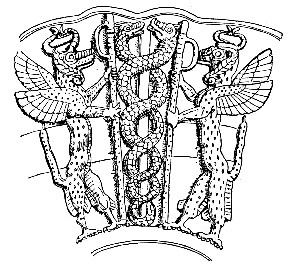 | ||
Ningishzida (sum: dnin-g̃iš-zid-da) is a Mesopotamian deity of the underworld. His name in Sumerian is translated as "lord of the good tree" by Thorkild Jacobsen.
Contents
Mythology
In Sumerian mythology, he appears in Adapa's myth as one of the two guardians of Anu's celestial palace, alongside Dumuzi. He was sometimes depicted as a serpent with a human head.
Lagash had a temple dedicated to Ningishzida, and Gudea, patesi of Lagash in the 21st century BC (short chronology), was one of his devotees. In the Louvre, there is a famous green steatite vase carved for King Gudea of Lagash, dedicated by its inscription: "To the god Ningiszida, his god Gudea, Ensi (governor) of Lagash, for the prolongation of his life, has dedicated this".
Ningishzida is sometimes the son of Ninazu and Ningiridda, even though the myth Ningishzida's journey to the netherworld suggests he is the son of Ereshkigal. Following an inscription found at Lagash, he was the son of Anu, the heavens.
His wife is Azimua and also Geshtinanna, while his sister is Amashilama. In some texts Ningishzida is said to be female, which means "Nin" would then refer to Lady, which is mostly how the word is used by the Sumerians. He or she was one of the ancestors of Gilgamesh.
Analogues in other cultures
Ningishzida is the earliest known symbol of snakes twining around an axial rod. It predates the Caduceus of Hermes, the Rod of Asclepius and the biblical Nehushtan of Moses by more than a millennium. One Greek myth on the origin of the caduceus forms part of the story of Tieresias, who finds two snakes copulating and kills the female with his staff.
Although Wadjet, "the Green One", the serpent goddess of Lower Egypt from the Pre-dynastic period demonstrates the earliest known representation of a single serpent entwined around a pole – in this case a papyrus reed (refer to first glyph): Wadjet Hieroglyph
The Adapa myth mentions Ningizzida and Tammuz (or Dumuzi) and refers to the serpent god as male.
